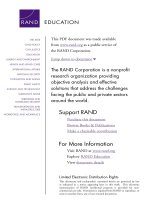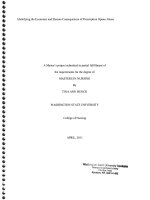HDAC INHIBITOR TARGETED THERAPY WITH NANOMEDICINE INCREASES THE EFFICACY OF PACLITAXEL IN TRIPLE NEGATIVE BREAST CANCER
Bạn đang xem bản rút gọn của tài liệu. Xem và tải ngay bản đầy đủ của tài liệu tại đây (11.61 MB, 56 trang )
HDAC INHIBITOR-TARGETED THERAPY WITH
NANOMEDICINE INCREASES THE EFFICACY OF
PACLITAXEL IN TRIPLE NEGATIVE BREAST
CANCER
LIM CHEN SIEW
B.Eng. (Hons), NUS
A THESIS SUBMITTED FOR THE DEGREE OF
MASTER OF ENGINEERING BY RESEARCH
DEPARTMENT OF CHEMICAL AND
BIOMOLECULAR ENGINEERING
NATIONAL UNIVERSITY OF SINGAPORE
2014
DECLARATION!
!
I hereby declare that this thesis is my original work and it has been written by
me in its entirety. I have duly acknowledged all the sources of information
which have been used in the thesis.
This thesis has also not been submitted for any degree in any university
previously.
_______________________
Lim Chen Siew
13 January 2014
ACKNOWLEDGEMENTS
I would like to take this opportunity to thank my supervisors, Assistant
Professor David LEONG and Professor FENG Si-Shen, for their constant
guidance and encouragement throughout my Masters studies.
I would also like to extend my thanks to the other members of the group for
their kind advices and assistance: MI Yu, ZHAO Jing, Rajaletchumy Veloo
KUTTY, TAN Guang Rong, Dalton TAY, Marcella GIOVANNI, CHIA Sing
Ling and Magdiel Inggrid SETYAWATI. And also to the lab technologists
and operators whom I greatly appreciate their help and services.
Last but not least, I would like to thank my family and friends for their
unwavering support and understanding.
i!
TABLE OF CONTENTS
!
ACKNOWLEDGEMENTS .............................................................................i
TABLE OF CONTENTS ............................................................................... ii
ABSTRACT .....................................................................................................iv
LIST OF TABLES ........................................................................................... v
LIST OF FIGURES ........................................................................................vi
LIST OF SYMBOLS .................................................................................... vii
1.
INTRODUCTION .................................................................................... 1
1.1
Triple Negative Breast Cancer.............................................................. 1
1.2
Therapeutic Resistance ......................................................................... 2
1.3
Cancer and Epigenetics......................................................................... 3
1.3.1 Histone Deactylases (HDACs)................................................. 4
2.
1.4
Epigenetics-targeted therapy using inhibitors of HDACs .................... 5
1.5
Combination Chemotherapy with Paclitaxel ........................................ 6
1.6
Challenges in Conventional Chemotherapy ......................................... 8
1.7
Nanomedicine ....................................................................................... 8
1.8
Problem Statement .............................................................................. 10
MATERIALS AND METHODS ........................................................... 11
2.1
Materials ............................................................................................. 11
2.2
Formulation of paclitaxel- and vorinostat-loaded DSPEPEG2000/TPGS micelles................................................................... 12
2.3
Characterization of micelles ............................................................... 12
2.3.1 Micelle shape, size and size distribution and surface charge . 12
2.3.2 Drug encapsulation efficiency................................................ 12
2.3.3 Critical micelle concentration (CMC) .................................... 13
2.4
Drug release profile ............................................................................ 13
2.5
in vitro studies..................................................................................... 14
ii!
2.5.1 Cell cultures ........................................................................... 14
2.5.2 Cellular uptake ....................................................................... 14
2.5.3 MTT cell viability .................................................................. 15
2.5.4 Cell cycle analysis .................................................................. 16
2.5.5 Caspase-3 activity .................................................................. 16
2.5.6 Scratch wound-healing assay ................................................. 17
2.6
3.
Statistical analysis ............................................................................... 17
RESULTS AND DISCUSSIONS ........................................................... 18
3.1
Characterization of micelles ............................................................... 18
3.1.1 Micelle shape, size and size distribution and surface charge . 18
3.1.2 Drug encapsulation efficiency................................................ 20
3.1.3 Critical micelle concentration (CMC) .................................... 21
3.2
Drug release profile ............................................................................ 23
3.3
in vitro studies..................................................................................... 24
3.3.1 Cellular uptake ....................................................................... 24
3.3.2 MTT cell viability .................................................................. 27
3.3.3 Cell cycle analysis .................................................................. 31
3.3.4 Capase-3 activity .................................................................... 33
3.3.5 Scratch wound-healing assay ................................................. 34
4.
CONCLUSIONS ..................................................................................... 36
5.
REFERENCES ....................................................................................... 37
!
!
!
iii!
ABSTRACT
Triple negative breast cancer is often associated with poor prognosis and high
relapse, which are linked to drug resistance to chemotherapy. Drug resistance
is a stumbling block in successful cancer treatment and metastatic cancers due
to chemoresistance accounts for more than 90% of cancer deaths. It is thus
crucial to develop new strategies to overcome drug resistance and enhance
efficacy especially in the early setting of TNBC when it is chemo-sensitive
and controllable. Epigenetic aberrations play an important role in modulating
resistance and by relying on epigenetics-targeted therapy, these defects could
be reversed to their normal state and prevented from passing on to future
generations. In this study, a novel system involving the co-encapsulation of
vorinostat, a histone deactylase inhibitor, and paclitaxel in mixed micelles
consisting of vitamin E TPGS and DSPE-PEG2000 was developed to achieve
maximal therapeutic response by targeting different mechanisms of action.
Results showed that the TPGS/DSPE-PEG2000 mixed micelles exhibited
enhanced cellular uptake and stability. In vitro investigations also suggested
that the micelle system led to improved pharmacokinetics and enhanced
anticancer activity as the IC50 value decreased from 3.071 in the free drugs
formulation to 0.520 μg/ml. The cell cycle profile also showed a significant
and sustained cell cycle arrest in the G2/M phase at 93%. Inhibition of cell
migration activity was observed where the wound area only recovered by 2.93
± 0.01 % compared to 100% in untreated cells. Significant caspase-3 activity
involved in apoptosis was also found.
iv!
LIST OF TABLES
!
Table 1: Size distribution and zeta potential of dual drug loaded DSPEPEG2000/TPGS micelles and TPGS micelles ................................ 19
Table 2: Encapsulation efficiency and drug load of dual drug loaded DSPEPEG2000/TPGS micelles and TPGS micelles ................................ 20
Table 3: IC50 values of different formulations in MDA-MB-231 after a 24hour incubation ................................................................................ 29
v!
LIST OF FIGURES
Figure 1:
Schematic illustration of the formulation of paclitaxel- and
vorinostat-loaded DSPE-PEG2000/TPGS mixed micelles ........... 11
Figure 2:
Transmission electron microscopy image of paclitaxel- and
vorinostat-loaded DSPE-PEG2000/TPGS mixed micelles ........... 19
Figure 3: (A) Excitation spectra of pyrene in DSPE-PEG2000/TPGS
micelles and (B) plot of fluorescence intensity ratio I336/I330 from
the excitation spectra versus DSPE-PEG2000/TPGS concentration
....................................................................................................... 22
Figure 4:
Drug release profile of (A) paclitaxel and (B) vorinostat in dual
drug-loaded TPGS and DSPE-PEG2000/TPGS micelles over 169
hours. * p < 0.05. .......................................................................... 24
Figure 5:
Quantitative cellular uptake efficiency of C6, C6-loaded TPGS
micelles and C6-loaded DSPE-PEG2000/TPGS micelles at
varying concentrations after a (A) 0.5-hour and (B) 2-hour
incubation. * p < 0.05 compared with C6. .................................... 25
Figure 6:
Cellular uptake and intracellular localization of (A) negative
control, (B) C6 and (C) C6-loaded DSPE-PEG2000/TPGS
micelles in MDA-MB-231 cells after a 2-hour incubation ........... 27
Figure 7:
(A) Effect of concentration of the blank micelles on the viability of
MDA-MB-231 cancer cells and (B) effect of concentration of the
indicated formulations on the viability of MDA-MB-231 cancer
cells after incubation for 24 hours. * p < 0.05 compared with
control. .......................................................................................... 30
Figure 8:
(A) Cell cycle distribution by flow cytometry where MDA-MB231 cancer cells were treated with the indicated formulations for
24 hours and (B) the effect of the different formulations on MDAMB-231 cancer cells arrested in the various cell cycle phases ..... 32
Figure 9:
Fold-increase in caspase-3 activity of the indicated formulations
compared with control in MDA-MB-231 cells after treatment for
24 hours. * p < 0.05 compared with control. ................................ 33
Figure 10: (A) Cell migration in a scratch wound-healing assay where MDAMB-231 cancer cells were treated with the indicated formulations
for 24 hours and (B) the effect of the different formulations on
wound closure in percentage. * p < 0.05 compared with control. 35
vi!
LIST OF SYMBOLS
ABCB1
ATP-binding cassette sub family B member 1
ACN
Acetonitrile
ATCC
American type culture collection
ATP
Adenosine triphosphate
C6
Coumarin 6
CDKN2A
Cyclin-dependent kinase inhibitor 2A
CLSM
Confocal laser scanning microscope
CMC
Critical micelle concentration
CpG
Cytosine-phosphate-guanine
CSC
Cancer stem cell
CTCF
Corrected total cell fluorescence
DAPI
4',6-diamidino-2-phenylindole
DLS
Dynamic light scattering
TPGS
D-α-tocopheryl polyethylene glycol 1000 succinate
DCM
Dichloromethane
DMSO
Dimethyl sulfoxide
DNA
Deoxyribonucleic acid
DSPE-PEG2000
1,2-distearoyl-sn-glycero-3-phosphoethanolamine
polyethylene glycol 2000
EDTA
Ethylenediaminetetraacetic acid
EPR
Enhanced permeability and retention
ER
Estrogen
FBS
Fetal bovine serum
FDA
Food and drug administration
FETEM
Field emission transmission electron microscope
vii!
HAT
Histone acetyltransferase
HER2
Human epidermal growth factor 2
HPLC
High performance liquid chromatography
HSP-90
Heat shock protein 90
IC50
Inhibitory concentration 50
HDAC
Histone deactylase
HDACi
Histone deactylase inhibitor
Ixxx
Intensity at xxx nm
MTT
3-(4,5-dimethyl-2-thiazolyl)-2,5-diphenyl-2Htetrazolium bromide
MWCO
Molecular weight cut-off
NaOH
Sodium hydroxide
P
Paclitaxel
P+S
Paclitaxel and vorinostat
Pmic
Paclitaxel-loaded DSPE-PEG2000/TPGS micelles
Pmic + Smic
Paclitaxel-loaded DSPE-PEG2000/TPGS micelles and
vorinostat-loaded DSPE-PEG2000/TPGS micelles
(P+S)mic
Paclitaxel- and vorinostat-loaded DSPE-PEG2000/TPGS
micelles
P-gp
P-glycoprotein
PBS
Phosphate buffered saline
pCR
Pathological complete response
PEG
Poly(ethylene) glycol
PFA
Paraformaldehyde
PI
Propidium iodide
PR
Progesterone
RES
Reticuloendothelial system
RNase A
Ribonuclease A
viii!
S
Suberoylanilide hydroxamic acid or vorinostat
Smic
Vorinostat-loaded DSPE-PEG2000/TPGS micelles
THF
Tetrahydrofuran
TNBC
Triple negative breast cancer
UV
Ultraviolet
VEGF
Vascular endothelial growth factor
ix!
1.
INTRODUCTION
1.1
Triple Negative Breast Cancer
Triple negative breast cancer (TNBC) is one of the most difficult breast
cancers to treat. Although it accounts for about 15% of all invasive breast
cancers, a large number of breast cancer deaths are associated with TNBC due
to aggressive tumor behavior and poor clinical outcome. Not expressing any
receptors for progesterone (PR), estrogen (ER) and the human epidermal
growth factor 2 (HER2), it is also not responsive to hormonal (i.e. tamoxifen)
and HER2-targeted therapies (i.e. Herceptin®), which are generally effective
for most breast cancers (Foulkes, Smith, & Reis-Filho, 2010; Hudis & Gianni,
2011; Isakoff, 2010; O’Toole et al., 2013; Podo et al., 2010; Shastry &
Yardley, 2013).
With no specific targets on TNBC, the standard treatment typically involves
systemic cytotoxic chemotherapy, surgery or radiation. Combinatory
chemotherapy before surgery is frequently utilized in a complex disease such
as TNBC where it consists of heterogeneous groups of tumors. It is believed
that administration of two or more anticancer agents that target different
mechanisms of action could maximize the therapeutic effect and reduce drug
resistance (Greco & Vicent, 2009; Pinto, Moreira, & Simões, 2011). Patients
are responsive to taxanes- and anthracyclines-based treatment regimes;
according to neoadjuvant studies, favorable prognosis is associated with
patients showing a pathological complete response (pCR). However, despite
success in the early setting of TNBC, patients still have a greater risk of
relapse and developing visceral metastases with worse survival rates after
treatment than non-TNBC patients (Arnedos, Bihan, Delaloge, & Andre,
2012; Isakoff, 2010). It has been suggested that a small subpopulation of
resistant cells present in TNBC called cancer stem cells (CSCs) might play a
role in the less favorable outcome encountered in TNBC patients.
The poor prognosis and high risk of relapse pose to be a clinical challenge for
TNBC; hence, it is crucial to develop new strategies to overcome drug
1
resistance and to enhance efficacy especially in the early setting when TNBC
is chemo-sensitive and controllable.
1.2
Therapeutic Resistance
Drug resistance to chemotherapy is a stumbling block in successful cancer
treatment that affects the survival rates of patients where metastatic cancers
due to chemoresistance accounts for more than 90% of cancer deaths
(Abdullah & Chow, 2013). Therapeutic resistance can arise from tumor cells
that are intrinsically resistant as well those that have acquired resistance
during treatment.
According to the hierarchical model of cancer progression, there exists a small
subpopulation of cells within the tumor called the cancer stem cells (CSCs)
that are intrinsically refractory to treatment and that explain the relapse of
cancer and metastasis. Depending on the type of cancer involved, the
proportion of CSCs accounts for 0.1% to 30% in tumors. Being capable of
self-renewal, CSCs that survive after treatment develop new and more
malignant tumors, which lead to the development of acquired drug-resistant
cancer cells and also poor prognosis (Basile & Aplin, 2012; Buchstaller,
Quintana, & Morrison, 2008; Dean, Fojo, & Bates, 2005; Vinogradov & Wei,
2012). In solid tumors such as breast tumors, the expression of the phenotype
CD44+/CD24- is characteristic of CSCs. MDA-MB-231, a TNBC cell type,
shows a high percentage of the CD44+/CD24- biomarker which is indicative of
CSCs.
The main mechanism for this phenomenon involves the expression of drug
efflux transporter protein called the P-glycoprotein (P-gp). P-gp is a
phosphoglycoprotein. It is also known as the ATP-binding cassette sub family
B member 1 (ABCB1) transporter protein and contains two ATP-binding
cassette domains. The presence of hydrophobic drugs would activate the
binding of the drugs to the ATP-binding cassette domains that result in the
hydrolysis of ATP. This subsequently leads to a change in the conformation of
2
P-glycoprotein and enhances the efflux of the drugs from the cells, which then
prevents drug-induced apoptosis and impairs the normal functioning of the
cell cycle checkpoints (Fojo & Bates, 2003; Gottesman, 2002; Kavallaris,
2010).
The high relapse rate and the tumor heterogeneity encountered in TNBC
suggest that cancer stem cells may be accountable for therapeutic resistance.
Hence, novel treatments have to be developed to prevent the formation of
drug-resistant cells as well as to decrease their resistance to anticancer agents.
1.3
Cancer and Epigenetics
Cancer was believed to be caused by genetic changes alone but there are
increasing evidence to show that epigenetic events play an important role in
modulating cancer progression and resistance. Epigenetic events are caused by
chromatin changes that in turn modify gene expression without any DNA
sequence alterations. Unlike genetic defects, epigenetic aberrations could be
reversed to their normal state by targeting epigenetic enzymes responsible for
the abnormalities, which makes them attractive targets for anticancer
treatment as well as countering therapeutic resistance. Epigenetic changes are
heritable and affect the global state of the cells; thus, reversing cancer
phenotypes via epigenetic-targeted therapy could prevent the epigenetic errors
from being passed on to future generations (Balch & Nephew, 2013; Baylin,
2011; Hoey, 2010; Kristensen, Nielsen, & Hansen, 2009; Pandian &
Sugiyama, 2012; Perego, Zuco, Gatti, & Zunino, 2012; Rodríguez-Paredes &
Esteller, 2011; Wilting & Dannenberg, 2012).
Epigenetic aberrations are mainly modulated by DNA methylation and histone
modifications in an interdependent manner. DNA methylation occurs at the
CpG islands or the regions in the genome that contains cytosine and guanine,
and is located at about 70% of the gene promoter sites (Dworkin, Huang, &
Toland, 2009). Hypermethylation of DNA sequences leads to the repression of
tumor suppressor genes due to the steric hindrance encountered by
3
transcription complexes when accessing the promoter in a closed chromatin
configuration. The nucleosome constitutes the fundamental unit of the
chromatin and consists of DNA wrapped around eight histones. Posttranslational modification of the histones, which include acetylation,
methylation, and phosphorylation, affects the chromatin configuration and
alter gene expression. In histone acetylation, the equilibrium state is mediated
by the counter activities of histone acetyltransferases (HATs) and histone
deactylases (HDACs). HATs are transcription activators that transfer an acetyl
group to the lysine residue of histones while conversely; HDACs act to
counter the acetylation activity by removing the acetyl groups. However,
hypoacetylation results in a closed chromatin configuration and silenced gene
expression. When the genes methylated or histones modified are associated
with cell cycle regulation, apoptosis, DNA repair and cell adhesion,
carcinogenesis occurs (Cortez & Jones, 2008; Ellis, Atadja, & Johnstone,
2009; Jones & Baylin, 2002; Jovanovic, Rønneberg, Tost, & Kristensen, 2010;
Zeller & Brown, 2010; Zhou et al., 2009).
1.3.1
Histone Deactylases (HDACs)
There are a total of eighteen histone deacetylases (HDACs) in humans and
they fall under three main classes depending on their homology to yeast
proteins. Class I HDACs are found mainly residing within the nucleus and
contribute to the survival and differentiation of the cells; they include HDAC
1, 2, 3 and 8. Class II HDACs can be found in the nucleus or the cytoplasm
and perform roles that are specific to the tissue; they include HDAC 4, 5, 7
and 9. HDAC 6 and 10 that contain two catalytic sites belong to the subclass
Class IIa. HDAC 11 is uniquely classified under Class IIb as it has conserved
residues identified in the catalytic sites that are shared by both Class I and II.
These HDAC proteins identified above contain zinc in their catalytic core
regions and also target non-histone proteins that play a role in regulating cell
differentiation and apoptosis. Another class of HDACs known as Class III or
the sirtuin family does not have non-histone substrates. HDACs catalyse the
4
removal of acetyl groups from lysine residues at the NH2-terminal of histones
and also interact with non-histone substrates such as transcription factors, coactivators and co-repressors (Dokmanovic, Clarke, & Marks, 2007; Frew,
Johnstone, & Bolden, 2009; P a Marks & Xu, 2009; New, Olzscha, & La
Thangue, 2012).
1.4
Epigenetics-targeted therapy using inhibitors of HDACs
HDACs enzymes that have impaired regulation could change gene expression
levels and lead to abnormal cell growth (Carew, Giles, & Nawrocki, 2008;
Cortez & Jones, 2008; Grant, Easley, & Kirkpatrick, 2007; Kaiser, 2010; Paul
a Marks & Breslow, 2007). Thus, using inhibitors of histone deactylase
(HDACi) that facilitate the accumulation of acetylated histone and non-histone
proteins to induce cell cycle arrest and apoptosis would be a promising target
in cancer therapy.
Suberoylanilide hydroxamic acid (S), known commercially as vorinostat
(Zolinza), is an FDA approved HDACi drug for the treatment of cutaneous Tcell lymphoma. It targets multiple agents from inhibiting HDACs of Class I
and II at nanomolar concentrations to non-histone proteins involved in gene
expression regulation; this accounts for its efficacy as an anticancer agent as
cancers are usually caused by multiple epigenetic aberrations. Some examples
of the non-histone substrates include transcription factor complexes,
retinoblastoma protein in cell proliferation, heat shock protein i.e. HSP-90 in
protein stability, α-tubulin in cell motility and hypoxia-inducible factor-1α in
angiogenesis. The mechanism of action by vorinostat is complex and not well
understood but it is believed to induce cell growth arrest and cell death via the
intrinsic and extrinsic apoptotic pathway, autophagy as well as reactive
oxygen species-mediated apoptosis (Dokmanovic et al., 2007; Ververis,
Hiong, Karagiannis, & Licciardi, 2013; Xu, Parmigiani, & Marks, 2007). In
particular, vorinostat could lead to retinoblastoma-mediated cell cycle arrest in
phase G1/S by targeting cyclin-dependent kinase inhibitor p21 encoded by
CDKN2A that is upregulated in TNBC (Paul a Marks & Breslow, 2007).
5
Phase I clinical trials with vorinostat as a monotherapy treatment were
evaluated in patients with hematologic and solid cancers administered
intravenously and orally. Minimal anticancer activity was reported and it is
suggested that vorinostat is not effective alone and has to be used in
combination chemotherapy to achieve greater therapeutic effect (Prince,
Bishton, & Harrison, 2009). There has been increasing interest in using
vorinostat in TNBC where it has been reported to inhibit brain metastatic
colonization and induce the breakage of DNA strands (Palmieri et al., 2009). It
has also been suggested to sensitize the TNBC cells to certain cisplatin and
PARP inhibitor treatment (Bhalla et al., 2012). Thus, it would be interesting to
further explore the therapeutic effects of vorinostat in TNBC with another
chemotherapy regime such as taxanes.
1.5
Combination Chemotherapy with Paclitaxel
Taxanes or microtubule inhibitors are recognized as effective anticancer drugs
in the treatment of breast cancers and TNBC. Clinical studies involving ERnegative subtypes have demonstrated that pCR was higher when taxanes were
added (Isakoff, 2010), thus emphasizing the importance of taxanes in the
treatment of ER-negative breast cancers.
One example of drugs in the class of taxanes is paclitaxel (P), or Taxol® as it
is commercially known, which was approved by FDA in 1992 for the
treatment of advanced ovarian cancer and later in 1994 for metastatic breast
cancer. Paclitaxel is a semi-synthetic drug that acts on microtubules.
Microtubules form a part of the cytoskeleton and are located at the centrosome
in the cytoplasm. The fundamental subunits that account for the structure
consist of the α-tubulin and β-tubulin monomers. The polymerization and
depolymerization of the microtubules via the addition and removal of these
tubulin monomers play a role in various important cellular activities such as
cell movement and mitosis. Paclitaxel stabilizes microtubules by binding to
the β-tubulin subunit and thereby minimizes depolymerization. Three possible
6
consequences can arise in the presence of paclitaxel: cell death at G1 phase,
cell cycle arrest in the G2/M phase that subsequently induces apoptosis or
mitotic slippage (Gascoigne & Taylor, 2009; Horwitz et al., 1986; Kavallaris,
2010; McGrogan, Gilmartin, Carney, & McCann, 2008).
Docetaxel is another member of the taxane family that works on inhibiting
microtubule division. Even though it is more potent and more water-soluble
than paclitaxel, docetaxel is more susceptible to drug resistance and there are
also less side effects associated with paclitaxel (Leung, Tannock, Oza,
Puodziunas, & Dranitsaris, 2010). Furthermore, the combination of paclitaxel
and vorinostat and another drug of interest as chemotherapy treatment is more
often encountered in literature (Owonikoko et al., 2010; Ramalingam et al.,
2010; Ramaswamy et al., 2012; Siegel et al., 2009). No specific studies on the
combinatory treatment of docetaxel and a HDAC inhibitor were found;
docetaxel was more frequently associated with platinum-based drugs such as
cisplatin and carboplatin in clinical studies (Kashima, Aoki, Yahata, &
Tanaka, 2005; Pentheroudakis et al., 2008; Takekida et al., 2010; Vasey et al.,
1999). It was also reported that paclitaxel was more effective in breast cancer
models, in particular MDA-MB-231 cells, whereas docetaxel was more
effective in solid malignancies such as non-small cell lung cancer (Izbicka,
Campos, Carrizales, & Tolcher, 2005). Thus, paclitaxel is selected as the
taxane of choice in this study due to its higher efficacy in breast cancer
models, which would have more impact in the field of triple negative breast
cancer.
Treatment combining epigenetics and anti-mitotic targeted therapies could
improve the therapeutic response of single chemotherapy as using epigenetic
modulators such as vorinostat could prevent the formation of drug-resistant
colonies and reduce the resistance to anticancer agents (Bots & Johnstone,
2009; Greco & Vicent, 2009; Thurn, Thomas, Moore, & Munster, 2011).
Also, since both agents target different pathways of action, enhanced
antineoplastic activity could be achieved. Preclinical studies in ovarian cancer
have shown the synergism of the two drugs where enhanced cytotoxicity and
7
apoptosis were observed but no studies on the two drugs could be found in
triple negative breast cancer (Angelucci et al., 2010; Cooper et al., 2007;
Dietrich et al., 2010; Modesitt & Parsons, 2010).
1.6
Challenges in Conventional Chemotherapy
Even though concurrent chemotherapy would show enhanced anti-cancer
effects, its effectiveness is often hindered by the poor solubility of the drugs
and their toxicity levels which are not well-tolerated by the patients in clinical
trials.
Both paclitaxel and vorinostat are highly hydrophobic compounds. Hence,
paclitaxel is usually formulated with alcohol and Cremophor® EL in Taxol®
dosage form to improve bioavailability but hypersensitivity reactions
associated with the solvents can often result (Pinto et al., 2011). The side
effects associated include myelosuppression, alopecia, gastrointestinal
symptoms and also peripheral neuropathy. Furthermore, it is impractical to use
the intravenous formulation of vorinostat on a routine basis where it involves
suspending vorinostat in sodium hydroxide at a high pH of 11.2 in a phase I
clinical trial (Cai et al.). Some common side effects encountered in vorinostat
usage include anemia, thrombocytopenia, fatigue and diarrhea. Moreover,
different drug molecules with dissimilar pharmacokinetics and biodistribution
could lead to more serious side effects when combined. Thus, to fully
capitalize on the benefits of combination chemotherapy, a drug delivery
system free of organic solvents that can improve pharmacokinetics to
maximize therapeutic potential is desirable.
1.7
Nanomedicine
Nanocarrier drug delivery systems offer a solution to the problems
encountered
by
conventional
chemotherapy.
By
encapsulating
the
hydrophobic drugs in the core of the nanocarrier, the drugs can be delivered to
8
the tumor site with reduced toxicities and at a controlled rate without
significant loss of their activity (Hu, Aryal, & Zhang, 2010).
One of the advantages of using nanoparticulate system is the ability to control
the size and surface characteristics of the nanocarriers. Nanocarriers with a
size too small would risk being leaked into the blood capillaries whereas a size
that is too large would be easily recognized by the macrophages and removed
by the reticuloendothelial system (RES). A suitable size of up to 100 nm
would satisfy both criteria. A hydrophilic surface is required for the
nanocarriers to be protected from opsonisation and to escape clearance from
the RES for a longer circulatory time in the blood system. This can be
achieved by either coating the surface with a hydrophilic layer of
poly(ethylene) glycol (PEG) or synthesizing the nanocarriers with amphiphilic
polymers consisting of both hydrophobic and hydrophilic chains. The unique
feature of tumor tissues also enables drug carriers to accumulate passively at
the tumor sites by the enhanced permeability and retention effect (EPR).
Proliferating tumor tissues stimulate the production of new vessels to supply
them with more oxygen and nutrients, which are usually highly disorganized
with enlarged pores. The leaky vasculature and the lack of lymphatic drainage
contribute to the preferential accumulation of drug carriers in tumor tissues
(Alexis, Pridgen, Langer, & Farokhzad, 2010; Banerjee & Sengupta, 2011;
Cho, Wang, Nie, Chen, & Shin, 2008). Nanocarriers are also believed to be
able to mediate the development of chemoresistance by evading recognition
by the P-gp efflux pump through internalization by endocytosis due to their
small size. Free drug molecules are immediately pumped out of cells by the Pgp protein when they enter by passive diffusion. On the other hand,
nanocarriers are being engulfed by the plasma membrane and transported to
the tumor site of action via endosomal vesicles, which can partially bypass the
P-gp efflux pumps. The drug molecules are then released at sites far away
from the drug efflux pumps and thus could interact with the tumor cells more
efficiently (Dong & Mumper, 2010; Hu & Zhang, 2009).
9
Self-assembling polymeric micelles constructed from amphiphilic block copolymers have gained increasing interest as nanocarriers due to their attractive
properties. Other than being biodegradable, their small size ranging from 10 to
100 nm enables them to penetrate deeply into the tumors via the EPR effect
and they can successfully solubilize highly hydrophobic compounds
(Chandran, Katragadda, Teng, & Tan, 2010; Ebrahim Attia et al., 2011; Gill,
Kaddoumi, & Nazzal, 2012; Katragadda, Teng, Rayaprolu, Chandran, & Tan,
2011; Mu, Elbayoumi, & Torchilin, 2005; Tyrrell, Shen, & Radosz, 2010).
!
1.8
Problem Statement
In this study, a novel system involving the co-encapsulation of paclitaxel and
vorinostat in the core of the micelles, which are made up of D-α-tocopheryl
polyethylene glycol 1000 succinate (vitamin E TPGS or TPGS) and 1,2distearoyl-sn-glycero-3-phosphoethanolamine
polyethylene
glycol
2000
(DSPE-PEG2000) was developed. TPGS is the hydrophilic moiety of vitamin
E, which is used in a wide range of applications as an emulsifier, additive and
also an agent for inhibiting P-gp-mediated multidrug resistance (Mi, Liu, &
Feng, 2011; Mi, Zhao, & Feng, 2012; Muthu, Kulkarni, Liu, & Feng, 2012;
Zhang, Tan, & Feng, 2012). However, it is limited by its high critical micelle
concentration (CMC) of 0.2 mg/ml that causes the micelles to dissociate easily
especially under high dilution (Kim, Shi, Kim, Park, & Cheng, 2010; Kita &
Dittrich, 2011). Hence, a more hydrophobic surfactant such as DSPEPEG2000 is used together with TPGS to form a mixed micelle for enhanced
micelle stability.
MDA-MB-231 cells, a cell-line with a high percentage of CD44+/CD24- (>
30%), were used as the in vitro model of TNBC to investigate the biological
effects of the dual drug encapsulated micelles compared with the free drugs
formulations (Sheridan et al., 2006). The objective is to prove the
effectiveness of nanocarriers in inducing enhanced anti-cancer effects where
lower drug doses and sustained cell cycle arrest in G2/M phase can be
achieved.
10
Paclitaxel
Vorinostat
DSPE-PEG2000
hydrophilic
hydrophobic
Paclitaxel- & vorinostat-loaded
DSPE-PEG2000/TPGS micelles
TPGS
hydrophilic
hydrophobic
Figure 1: Schematic illustration of the formulation of paclitaxel- and
vorinostat-loaded DSPE-PEG2000/TPGS mixed micelles
!
2.
MATERIALS AND METHODS
2.1
Materials
Vitamin E TPGS (D-α-tocopheryl polyethylene glycol 1000 succinate,
C33O5H54(CH2CH2O)23) was purchased from Eastman Chemical Company,
USA. Paclitaxel (anhydrous, 99.5%) and vorinostat (anhydrous, 99.7%) were
bought from Tocris Bioscience, USA. DSPE-PEG2000 (1,2-distearoyl-snglycero-3-phosphoethanolamine-N-[methoxy(polyethylene
glycol)-2000]
(ammonium salt)) was purchased from Avanti Polar Lipids. Phosphate
buffered saline (PBS), penicillin-streptomycin solution, trypsin-EDTA
solution,
coumarin
6,
3-(4,5-dimethyl-2-thiazolyl)-2,5-diphenyl-2H-
tetrazolium bromide (MTT), ribonuclease A (Rnase A) from bovine pancreas,
pyrene, propidium iodide (PI), dimethyl sulfoxide (DMSO), chloroform,
dichloromethane (DCM), tetrahydrofuran (THF), paraformaldehyde (PFA),
acetonitrile (ACN) were from Sigma-Aldrich (St. Louise, MO, USA). Ethanol
was from VWR Singapore Pte Ltd, Alexa Fluor® 647 Phalloidin, ProLong®
Gold Anti-fade reagent with DAPI were from Invitrogen. RPMI-1640 was
bought from Thermo Scientific HyClone (South Logan, USA). All chemicals
used in this study were of HPLC grade. Ultra-pure water was produced by the
Milli-Q Plus System (Millipore Corporation, Bedford, USA). MDA-MB-231
11
breast cancer cells were provided by American Type Culture Collection
(ATCC).
2.2
Formulation
of
paclitaxel-
and
vorinostat-loaded
DSPE-
PEG2000/TPGS micelles
The paclitaxel- and vorinostat-loaded DSPE-PEG2000/TPGS or coumarin 6
(C6)-loaded micelles were fabricated by the solvent evaporation method. 1 mg
of paclitaxel and vorinostat (1 : 1 molar ratio) and 30 mg of TPGS and DSPEPEG2000 (1 : 1 weight ratio) were dissolved in chloroform which were then
evaporated using the rotary vacuum evaporator at 35 °C until a thin film of
drug-dispersed TPGS was formed. The film was further dried in vacuum
overnight and suspended in 10 ml of 1 × PBS buffer before being incubated in
an orbital water bath at 37 °C for 30 minutes followed by 15 minutes of
sonication. A 0.22-μm filter was used to separate the excess non-incorporated
drug from the suspension before characterization.
2.3
Characterization of micelles
2.3.1
Micelle shape, size and size distribution and surface charge
Micelle shape was visualized using the field emission transmission electron
microscope (FETEM, JEM-2200FS, JEOL, Japan). The suspension was
dropped on the surface of a copper grid with a carbon film and dried at room
temperature. Micelle size and size distribution as well as the zeta potential
were measured by dynamic light scattering (DLS) (Nano ZS, Malvern
Instruments, Malvern, UK). The suspension was diluted with ultra-pure water
and sonicated before measurement.
2.3.2
Drug encapsulation efficiency
The amount of paclitaxel or vorinostat encapsulated in the micelles was
measured using high performance liquid chromatography (HPLC, Agilent
12
LC1100, Agilent, Tokyo, Japan) in a reversed phase column (Eclipse XDBC18, 4.6 × 250 mm, 5 μm). 1 ml of micelles were freeze-dried and dissolved
in 1 ml of DCM followed by the evaporation of DCM overnight. The resulting
sample was dispersed in 1 ml of mobile phase consisting of ACN and water
(50 : 50 v/v) and then filtered with a 0.45-μm syringe filter before being
transferred into a HPLC vial. The flow rate of the mobile phase was set at 1
ml/min and the column effluent was detected with an UV/visible detector at
230 nm and 240 nm for paclitaxel and vorinostat respectively. The drug
encapsulation efficiency is defined as the ratio of the amount of drug
encapsulated in the micelles to that added during the formulation process.
2.3.3
Critical micelle concentration (CMC)
The critical micelle concentration of the micelles was estimated using the
pyrene as the fluorescent probe (Sawant & Torchilin, 2010). 50 μl of 1.8 × 10-4
M solution of pyrene in DCM was added to varying concentrations of DSPEPEG2000/TPGS in DCM ranging from 0.001 mg/ml to 0.6 mg/ml. A pyrene
film was formed after evaporating DCM for 24 hours followed by the addition
of 15 ml UP water to obtain a final pyrene concentration of 6.0 × 10-7 M. The
suspension was incubated in an orbital water bath at 37 °C for 24 hours to
reach equilibrium before being filtered through a 0.2-μm syringe filter to
remove the free pyrene. It was then transferred to a 96-well black microplate
where the fluorescence intensities were measured using the microplate reader
(Genios, Tecan, Männedorf, Switzerland). The excitation wavelength was
scanned from 306 nm to 346 nm and the emission wavelength at 373 nm.
2.4
Drug release profile
The dialysis bag diffusion technique was used to study the in vitro drug
release profile of paclitaxel and vorinostat. 4 ml of suspension was placed in a
dialysis bag (Spectra/Por® Dialysis Membrane, MWCO 10,000Da) and
immersed into 20 ml of 1 × PBS buffer containing 0.1% w/v Tween 80 at
13
37 °C with constant agitation. The incubation medium outside the dialysis bag
was collected at designated time intervals and replaced with fresh incubation
medium. The collected incubation medium containing the released drug was
then freeze-dried and dissolved in DCM. The amount of paclitaxel or
vorinostat was determined using HPLC in the procedure mentioned in 2.3.3.
2.5
in vitro studies
2.5.1
Cell cultures
MDA-MB-231 cancer cells used in the cell studies were cultured using RPMI1640 with 10% FBS and 1% penicillin-streptomycin. The cells were incubated
with 5% CO2 at 37 °C in a humidified incubator. Before the in vitro
experiments, the cells were pre-cultured until confluence was reached.
2.5.2
Cellular uptake
Quantitative cellular uptake
MDA-MB-231 cells were seeded in the 96-well black plates at 5,000
cells/well. After 24 hours, the medium were discarded and the cells in the
sample wells were incubated for 2 hours in the media containing C6-loaded
micelles at a concentration of 2.5, 0.25 and 0.025 μg/ml as chosen from
previous studies by the research group whereas the cells in the control wells
were incubated in 0.5% Triton X-100 in 0.2 N NaOH solution containing the
micelle suspensions. After incubation, the micelles suspension from the
sample wells was removed and washed three times with PBS followed by the
addition of 50 μl of 0.5% Triton X-100 in 0.2 N NaOH solution to the cells.
The fluorescence intensities from the C6-loaded micelles were then measured
using the microplate reader (Genios, Tecan, Männedorf, Switzerland) where
the excitation wavelength was set at 430 nm and the emission wavelength at
485 nm. Cellular uptake efficiency was then calculated to be the percentage of
14









